クラシックな幾何学的錯視の作品集17
2011年5月14日より

「遠藤の大きさ錯視」
それぞれの円内の3つの円あるいは楕円あるいは線分は同じ大きさあるいは長さであるが、中央のものが左右のものよりも小さくあるいは長く見える。
Copyright Akiyoshi Kitaoka 2011 (December 5)
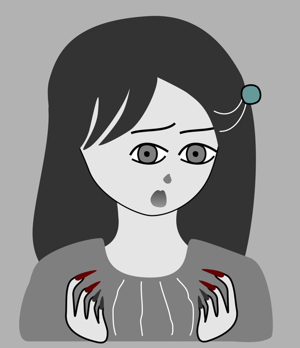
Copyright Akiyoshi Kitaoka 2011 (December 8)
![]() 琉球大学の遠藤光男先生が発見した。
琉球大学の遠藤光男先生が発見した。
![]() カニッツァの非感性的拡大(amodal expansion)では円と楕円の図が説明できない。
カニッツァの非感性的拡大(amodal expansion)では円と楕円の図が説明できない。

amodal expansion and amodal shrinkage
References
Kanizsa G, Luccio R, 1978 ``Espansione di superficie da completamento amodale'',
reports from the Institute of Psychology, University of Trieste, Trieste,
Italy.
Vezzani, S. (1999) Shrinkage and expansion by amodal completion: a critical
review. Perception, 1999, 28, 935-947.
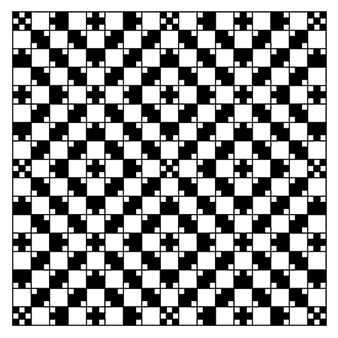
「サッカー」
(リメーク)
すべて正方形でできているが、ゆがんで見える。
Copyright Akiyoshi Kitaoka 2011 (December 8) (Originally around 1996)
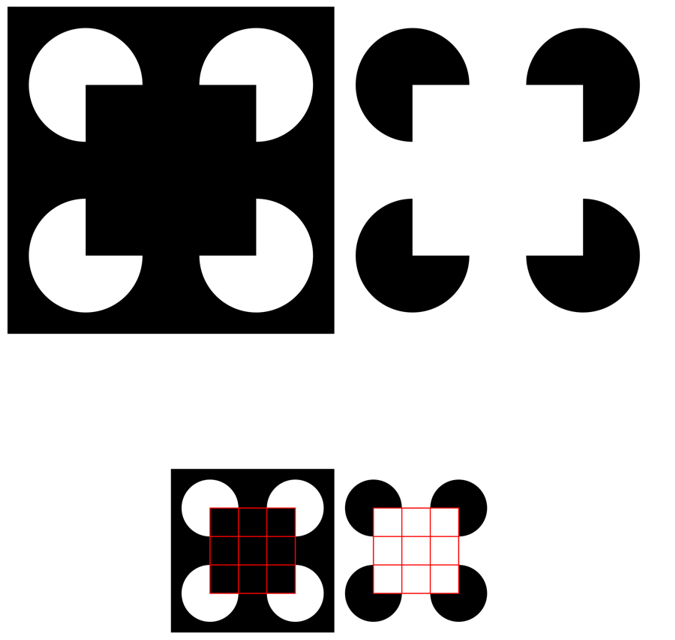
「カニッツァの正方形の大きさの錯視」
パックマンの半径と隣接するパックマンの最短距離(ギャップ)は等しいのであるが、後者の方が短く見える。イラディエーションのせいなのか、左の図の方が錯視量が多い。
Copyright Akiyoshi Kitaoka 2011 (November 10)
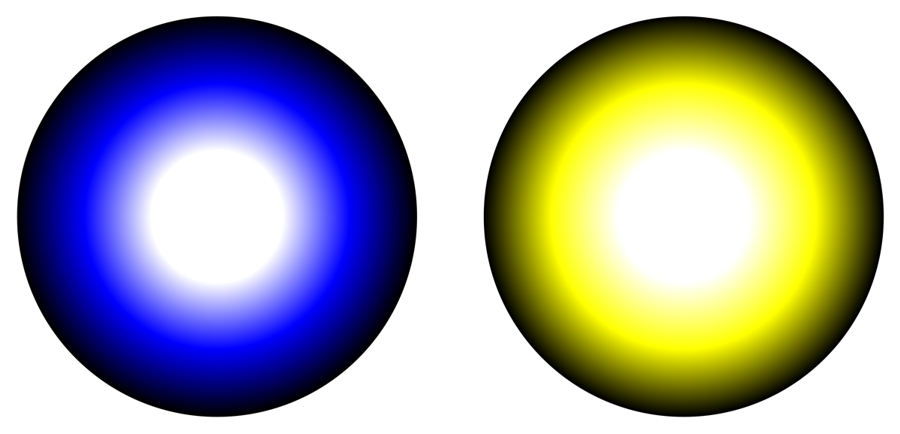
「マッハの帯の大きさ錯視」
左の青いマッハの帯と右の黄色のマッハの帯より小さく見えるが、青と黄のリングの直径は同じである。
Copyright Akiyoshi Kitaoka 2011 (November 6)

大きさというよりマッハの帯の位置の話だから、グラデーションを逆にすると大きさの関係も逆転する。この図では青のリングの方が大きく見える。

「正方形の大きさ錯視」
左右の正方形は同じ大きさであるが、右の方が大きく見える。
Copyright Akiyoshi Kitaoka 2011 (August 21)

「ダイヤモンド」
2本ずつ平行線を描いているように見えるが、すべて中心が同じ放射線である。
Copyright Akiyoshi Kitaoka 2011 (July 18)

「お箸」
横長長方形が、上は右すぼまり、下は左すぼまりに見える。
Copyright Akiyoshi Kitaoka 2011 (July 18)
これだとお子様用のお箸という感じ。

「シェパード錯視・モナリザ」
左のモナリザは右のモナリザよりもスマートに見える。
Copyright Akiyoshi Kitaoka 2011 (July 10)

「シェパード錯視・モナリザ 2」
左のモナリザは右のモナリザよりも背が高く見える。
Copyright Akiyoshi Kitaoka 2011 (July 10)

「向かって左がおねえさん」
左のモナリザは右のモナリザよりも背が高く見える(ミュラー・リヤー錯視、ウェイト・マッサロ錯視)。
Copyright Akiyoshi Kitaoka 2011 (July 10)

「ネクタイ錯視」
ネクタイを締めるとスマートに見える。左右の長方形は同じ大きさであるが、左の方が細く見える。
Copyright Akiyoshi Kitaoka 2011 (May 23)

「ヤンの虹彩錯視のデモ」
虹彩(黒目)は等間隔に描いてある。虹彩の位置が目の輪郭の鼻側にある場合(「アジア人顔」)、両眼の距離は隣の虹彩との距離と比較して大きく見える。一方、虹彩の位置が目の輪郭の耳側にある場合(「ヨーロッパ人顔」)、両眼の距離は隣の虹彩との距離と比較して小さく見える。
Copyright Akiyoshi Kitaoka 2011 (May 15)
References
Yang, J. and Schwaninger, A. (2011). Yang's iris illusion: External contour causes length-assimilation illusions. Japanese Psychological Research, 53, 15-29. Abstract
Top 10 of the Best Visual Illusion of the Year Contest 2008
Another demo

Akiyoshi's comments
The authors claimed Yang's iris illusion is quite new because this illusion is featured by length-assimilation though e.g. the Giovanelli illusion is a length-contrast effect. To my knowledge, however, the gravity-lens illusion (Naito and Cole, 1994) shows a length-assimilation effect. In each of the images shown below, four small dots are placed on the apices of a virtual parallelogram but the position of each dot appears to be shifted toward the large circle nearby. (内藤の重力レンズの仲間では?)
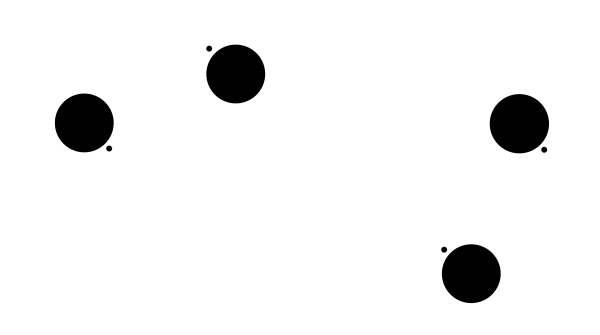

References
Naito, S. and Cole, J. B. (1994) The gravity lens illusion and its mathematical model. in G. H. Fischer and D. Laming (Eds.), Contributions to Mathematical Psychology, Psychometrics and Methodology. New York: Springer-Verlag (pp. 39-50).

Both Yang's iris illusion and the Giovanelli illusion work simultaneously. (ヤンの虹彩錯視とジョバネッリ錯視は同時に働く)

「T型錯視(Lee and Freire, 1999)」
左の縦長のTの入った楕円は、右の同じ楕円と比較して、縦長でスリムに見える。
Reproduced on May 21., 2011
References
Lee, K. and Freire, A. (1999). Effects of face configuration change on shape perception: A new illusion. Perception, 28, 1217-1226.
Yang, J. and Schwaninger, A. (2011). Yang's iris illusion: External contour causes length-assimilation illusions. Japanese Psychological Research, 53, 15-29. Abstract

さかさまでも同じ。

「Lee-Freire錯視のイラスト版(Lee and Freire, 1999)」
左の縦長の顔の入った楕円は、右の同じ楕円と比較して、縦長でスリムに見える。
Copyright Akiyoshi Kitaoka 2011 (May 21)

さかさまでも同じ。

「顔のポッゲンドルフ錯視」
顔で斜線を遮蔽した方がポッゲンドルフ錯視の錯視量が多いような気がする。
Copyright Akiyoshi Kitaoka 2011 (May 16)

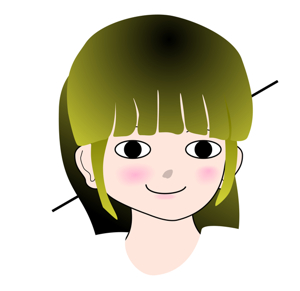

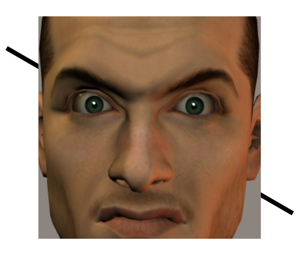
 (フィネアス・ゲイジではありません)
(フィネアス・ゲイジではありません)
Copyright Akiyoshi Kitaoka 2011 (May 21)

「鋭角不要のポッゲンドルフ錯視」
左上の線分は右下の線分の延長線よりも上にあるように見えるが、両者は一直線上にある。
Copyright Akiyoshi Kitaoka 2011 (May 14)

正立の顔を描くと錯視が強くなるようだ。倒立でも90度横倒しでも同様である。


顔の傾きが斜線の傾きと一致すると錯視量増強効果はナシあるいは錯視量減少効果があるようだ。

90度横倒し。

倒立。

「鋭角不要のポッゲンドルフ錯視 2」
左上の線分は右下の線分の延長線よりも左にあるように見えるが、両者は一直線上にある。(錯視少ない?)
Copyright Akiyoshi Kitaoka 2011 (May 14)
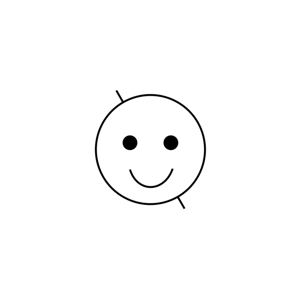
正立の顔を描くと錯視が強くなるようだ。倒立でも90度横倒しでも同様である。

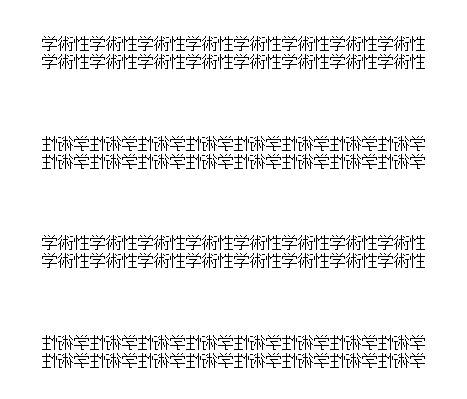
「学術性傾き錯視」
学術性文字列は右に傾いて見える。
Copyright Akiyoshi Kitaoka 2011 (May 16)